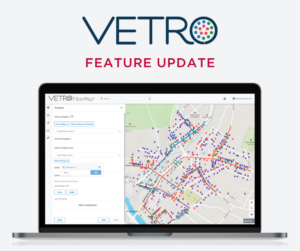Charting Your Course to a Profitable Fiber Deployment
In our last post, we discussed the complicated process of determining where you’re going to build your fiber network. There are a handful of things to take into consideration, including population density, census data, zoning laws, and access to state and local funding. If you missed it, you can check out that post right here.
Today’s post will be shorter, sweeter, and simpler: what are you actually going to build? What are the physical components of your network going to look like? A system of record like VETRO FiberMap will allow you to keep track of all your physical network assets, what equipment you have and where, and what the status of each asset is at any given time.
Placing Your Network Infrastructure
In the network design process, you’ll be determining where to locate your Optical Line Terminals, Local Concentration Points, Splice Cases, Multiport Splitter Terminals, and more. You’ll need to look at existing infrastructure, like pole availability and utility data. You’ll want to know how many utility poles you need to attach to, or how many handholes you’ll pass through. Keeping track of the existing power or telephone company inventory tracking numbers for those assets will be critical to getting the most value for your dollar in your network build.
At the same time, you’ll need to plan for the capacity of your network. Even if you’re the only provider in the area, it’s not realistic to expect that you’ll have a 100% take rate on your broadband service. Not everyone will be willing/able to sign up right away, and your marketing team may have to do some messaging to get the benefits of broadband in everyone’s mind. Competitive services like DOCSIS/Cable modem systems and even DSL will draw some customers away if those options exist.
An accurate estimate of your take rate goes hand-in-hand with building a network with the capacity to meet and exceed demand.
Understanding population data in your area allows you to plan on a capacity that is somewhat higher than your expected take rate, but not passing 100% of homes in your network area.
Managing Your Network Infrastructure
Once your infrastructure is in place, the fun can begin! On each route, fiber cables will need to be sized to serve your target passings, plus a few spares. You’ll also want to size main routes to support branching routes in addition to their own passings. Splitters, slack, and splice cases will need to be placed according to your design standards, meeting the requirements of installation as well as the eventual need for network restoration in the event a fiber line is severed.
Being prepared for service interruptions is part and parcel of being a network operator. Inclement weather, natural disasters, or even wildlife getting caught up in bits of your infrastructure are all real possibilities that you’ll need to address. Your fiber management system of record should allow you to easily locate, tag, and track each of these objects in a geospatial database. Concise, intuitive data will make your job so much easier if things go haywire down the line.
What’s Next?
Once you’ve done your due diligence, placed your infrastructure, and put a plan in place to address future incongruities, you’re looking at the how of it all. How am I going to get people connected? How am I going to get the word out about my lightning-fast broadband service? What steps should I take, from a marketing analysis standpoint, to make sure residents in my service area are educated and up to date on the possibilities of broadband?
In our next post, we’ll address these concerns, along with tips for mailing campaigns, marketing strategies, and more.
If you can’t wait, download our Guide to Building a Profitable Fiber Network.

